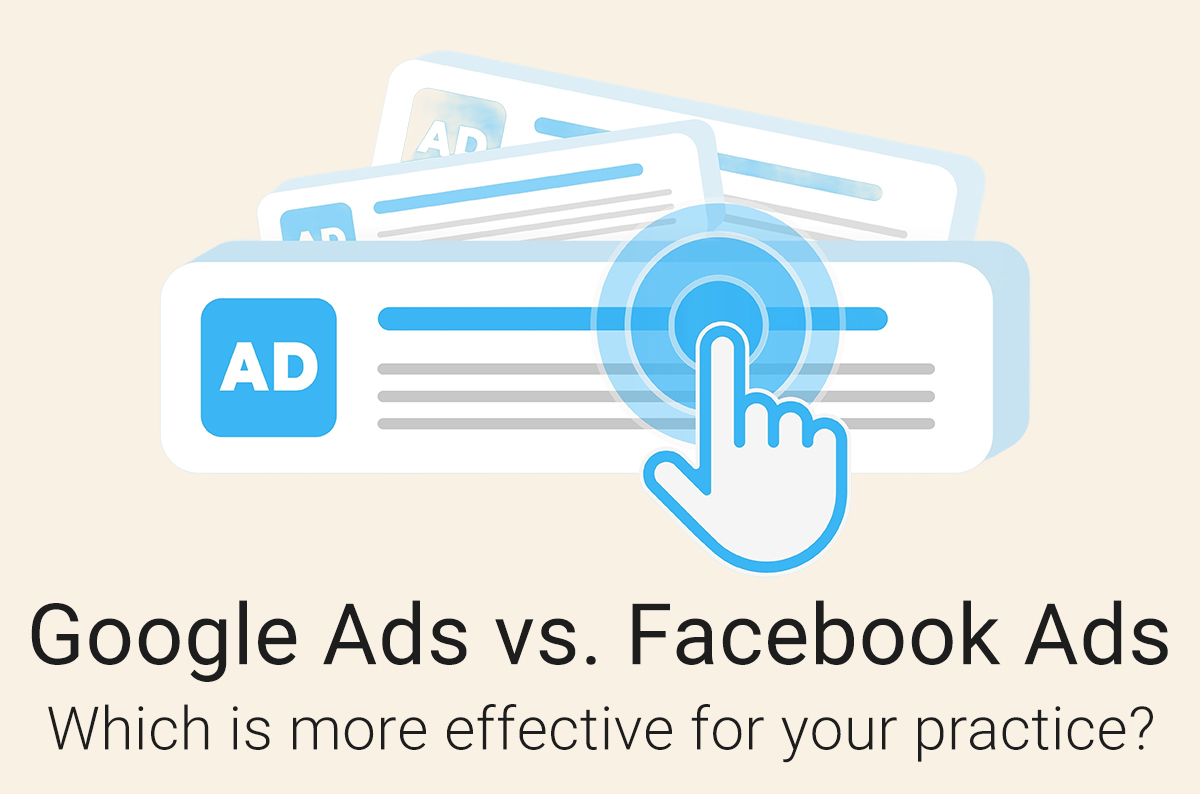Paid Advertising for Dentists: Google Ads vs. Facebook Ads
While there are multiple organic avenues for building a practice and acquiring new patients, eventually your dental marketing strategy will include paid digital advertising. The two powerhouse platforms are easily Google Ads and Facebook Ads, each with distinct differences and strengths in terms of audience targeting, ad formats, and user intent.
Facebook is the most popular social media tool with more than 3 billion monthly active users and Google obliterates the search engine competition with a 92% market share.
However, both platforms have their advantages depending on what your advertising objectives are. One of them is designed to pull your target audience to you while the other pushes your message out to the internet users. Let’s look at some key contrasts in the Facebook vs. Google smackdown:
1. Audience Intent
Google Ads: When people use the search engine, they typically have a specific intent or problem in mind. Ads on Google can target those users actively searching for dental services, such as “dentist near me” or “teeth whitening in Wilmington.” This means your pay-per-click ads are reaching those specifically seeking dental care.
Facebook Ads: As a social platform, Facebook users are usually there for personal updates and interactions, not necessarily to find a dentist. Facebook ads focus on capturing the attention of visitors who may not have immediate dental needs.
2. Targeting Options
Google Ads: Google offers precise targeting by keyword, geography, and demographic. You can show your ads to users based on their search queries, location, age, gender, and more, which ultimately helps you reach a highly relevant audience.
Facebook Ads: Thanks to its user data, Facebook advertising employs even more extensive demographic and interest-based targeting options. You can customize your ads to viewers based on factors like age, gender, interests, behaviors, and even life events.
3. Ad Formats
Google Ads: Google primarily offers text-based ads that appear at the top of search results. Images may be included. They also provide display ads on the Google Display Network that can appear on various websites.
Facebook Ads: A wide range of ad formats that include images, videos, carousels, and more are available on Facebook. Although they’re passive, these visual ads can be engaging and informative.
4. Cost Structure
Google Ads: Google Ads operate on a pay-per-click (PPC) basis, where you pay when someone clicks on your ad. The cost can vary based on competition for keywords, but it has an average cost per click of $2.69.
Facebook Ads: Facebook Ads can be set up with various bidding options, including CPC (cost per click), CPM (cost per thousand impressions), or CPA (cost per action). The cost can vary based on the ad objective and targeting, and typically run an average of $1.72 per click.
5. Tracking and Measurement
Google Ads: Google provides robust tracking and measurement tools, including conversion tracking, Google Analytics integration, and detailed reporting on ad performance.
Facebook Ads: Facebook also offers a comprehensive ability to track results, including the Facebook Pixel for website conversions and detailed insights into ad performance.
6. Content and Creatives
Google Ads: Ad copy for Google Ads needs to be concise, informative, and directly related to the user’s search query by incorporating essential keywords.
Facebook Ads: Facebook allows for more creative freedom with visually appealing ad formats. Text is limited within the image, but longer ad copy can effectively convey your message.
In Summary
To summarize, Google Ads are more effective for capturing users who are actively searching for dental services, while Facebook Ads are better suited for elevating your profile and engaging with a broader audience. The choice between these tools for dental marketing ultimately depends on your specific goals and target audience.
Ideally, it’s not an either/or choice because successful dental marketing plans integrate both platforms in a complementary manner – after all, the digital universe is vast, and your target audience is seldom found in one place.
With more than 20 years of dental marketing experience, RAMP can help you create a customized, comprehensive paid ad campaign based on your practice, your region, and your budget. Contact us today and schedule a free strategy session.
